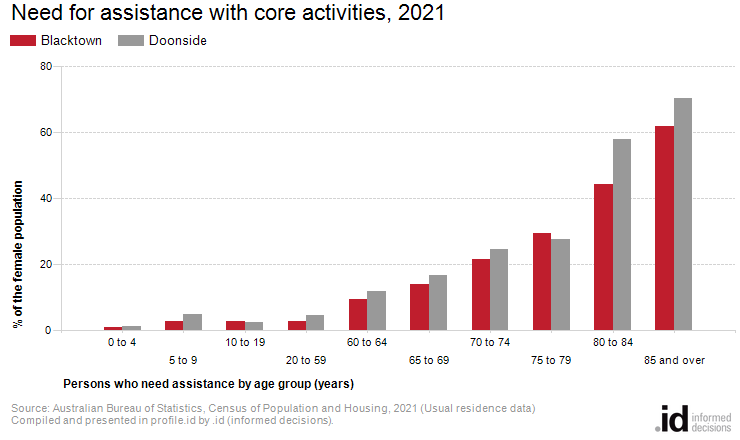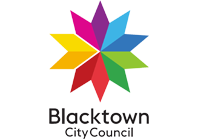Blacktown
Need for assistance
In 2021, 1,735 females (or 6.9% of the female population) in Blacktown reported needing help in their day-to-day lives due to disability. This was a percentage increase from 2006.
Blacktown's disability statistics relate directly to need for assistance due to a severe or profound disability. The information may be used in the planning of local facilities, services such as day-care and occasional care and in the provision of information and support to carers. Blacktown's disability statistics help in understanding the prevalence of people who need support in the community, and along with information on Unpaid Care to a person with a disability, how that support is provided.
Please note: A person's reported need for assistance is based on a subjective assessment and should therefore be treated with caution. See the specific data notes for further detail.
Derived from the Census questions:
'Does the person ever need someone to help with, or be with them for, self care activities?', 'Does the person ever need someone to help with, or be with them for, body movement activities?', 'Does the person ever need someone to help with, or be with them for, communication activities?', and 'What are the reasons for the need for assistance or supervision shown in questions 20, 21 and 22?' (as per above).
Total population
| Need for assistance with core activities by age | ||||||||
|---|---|---|---|---|---|---|---|---|
| Blacktown - Females (Usual residence) | 2021 | 2006 | Change | |||||
| Assistance needed by age group (years) | Number | % of total age group | Doonside % | Number | % of total age group | Doonside % | 2006 to 2021 | |
| 0 to 4 | 16 | 0.9 | 1.2 | 8001 | 10 | 0.7 | 0.7 | +6 |
| 5 to 9 | 42 | 2.7 | 4.7 | 8011 | 18 | 1.4 | 4.2 | +23 |
| 10 to 19 | 66 | 2.5 | 2.4 | 8021 | 18 | 0.7 | 3.0 | +47 |
| 20 to 59 | 396 | 2.7 | 4.5 | 8031 | 241 | 2.2 | 2.8 | +154 |
| 60 to 64 | 106 | 9.2 | 11.7 | 8041 | 38 | 5.2 | 10.5 | +67 |
| 65 to 69 | 138 | 14.0 | 16.5 | 8051 | 63 | 8.1 | 9.2 | +75 |
| 70 to 74 | 176 | 21.3 | 24.4 | 8061 | 59 | 9.0 | 12.2 | +117 |
| 75 to 79 | 188 | 29.4 | 27.4 | 8071 | 167 | 27.2 | 34.0 | +21 |
| 80 to 84 | 230 | 44.2 | 57.9 | 8081 | 182 | 41.0 | 41.8 | +48 |
| 85 and over | 368 | 61.8 | 70.5 | 8091 | 203 | 64.3 | 47.5 | +165 |
| Total persons needing assistance | 1,735 | 6.9 | 8.3 | 1,003 | 5.1 | 5.1 | +731 | |
Source: Australian Bureau of Statistics, Census of Population and Housing (opens a new window) 2006 and 2021. Compiled and presented in profile.id by .id (opens a new window)(informed decisions).
Source: Australian Bureau of Statistics, Census of Population and Housing (opens a new window) 2006 and 2021. Compiled and presented by .id (opens a new window)(informed decisions).

Compiled and presented in profile.id by .id (informed decisions).

Compiled and presented in profile.id by .id (informed decisions).
Dominant groups
Analysis of the need for assistance of females in Blacktown City compared to Doonside shows that there was a lower proportion of females who reported needing assistance with core activities.
Overall, 6.9% of the female population reported needing assistance with core activities, compared with 8.3% for Doonside.
The major differences in the female age groups reporting a need for assistance in Blacktown and Doonside were:
- A smaller percentage of females aged 80 to 84 (44.2% compared to 57.9%)
- A smaller percentage of females aged 85 and over (61.8% compared to 70.5%)
- A smaller percentage of females aged 70 to 74 (21.3% compared to 24.4%)
- A smaller percentage of females aged 65 to 69 (14.0% compared to 16.5%)
Emerging groups
The major differences in the female age groups reporting a need for assistance between 2006 and 2021 in Blacktown were in the age groups:
- 85 and over (+165 females)
- 20 to 59 (+154 females)
- 70 to 74 (+117 females)
- 65 to 69 (+75 females)
